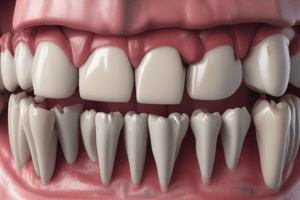Podcast
Questions and Answers
What does the term 'heterodont' refer to?
What does the term 'heterodont' refer to?
Humans have varying tooth shapes that align with the teeth’s individual function.
What is a diphyodont dentition?
What is a diphyodont dentition?
Humans have two sets of teeth.
What is the first set of teeth in humans called?
What is the first set of teeth in humans called?
Deciduous dentition
At what age do all primary teeth usually erupt?
At what age do all primary teeth usually erupt?
What are the classifications of teeth in human dentition?
What are the classifications of teeth in human dentition?
What is the significance of the FDI Two Digit System in dentistry?
What is the significance of the FDI Two Digit System in dentistry?
The first permanent tooth typically erupts at age ____.
The first permanent tooth typically erupts at age ____.
The total number of primary teeth is calculated as (Total no. of teeth in a half-arch) x ___.
The total number of primary teeth is calculated as (Total no. of teeth in a half-arch) x ___.
Humans only have one set of teeth throughout their lifetime.
Humans only have one set of teeth throughout their lifetime.
Flashcards are hidden until you start studying
Study Notes
Introduction to Oral Anatomy
- Oral anatomy is the study of the stomatognathic system, encompassing the teeth and supporting structures.
- Key terms: "stoma" refers to the mouth, while "gnatha" relates to the jaw or temporomandibular joint.
Dentition Formation
- Human dentition is classified as diphyodont and heterodont:
- Diphyodont means having two successive sets of teeth.
- Heterodont describes the variety of tooth shapes aligning with their functions.
Dental Formulas
- Dental formulas describe the types and number of teeth in a half-arch:
- Universal system uses letters and numbers. For example:
- I = incisor
- C = cuspid (canine)
- PM = premolar
- M = molar
- Universal system uses letters and numbers. For example:
Primary Dentition
- Primary teeth, also known as deciduous teeth, are the first set:
- Begin erupting around 6 months old.
- Usually, all primary teeth erupt by age 3.5.
- Total count: 20 primary teeth.
Permanent Dentition
- The second set of teeth, known as permanent dentition:
- First permanent tooth typically erupts around age 6.
- All permanent teeth should emerge by ages 17-25, excluding third molars.
- Total count: 32 permanent teeth.
Mixed Dentition
- Mixed dentition occurs when both primary and permanent teeth are present:
- Typically observed between ages 6-12 until all primary teeth are shed.
Types of Teeth
- Dentition is categorized into anterior and posterior teeth:
- Anterior Teeth (front teeth):
- Incisors and cuspids (canines).
- Posterior Teeth (at the corners):
- Premolars and molars.
- Anterior Teeth (front teeth):
Studying That Suits You
Use AI to generate personalized quizzes and flashcards to suit your learning preferences.




